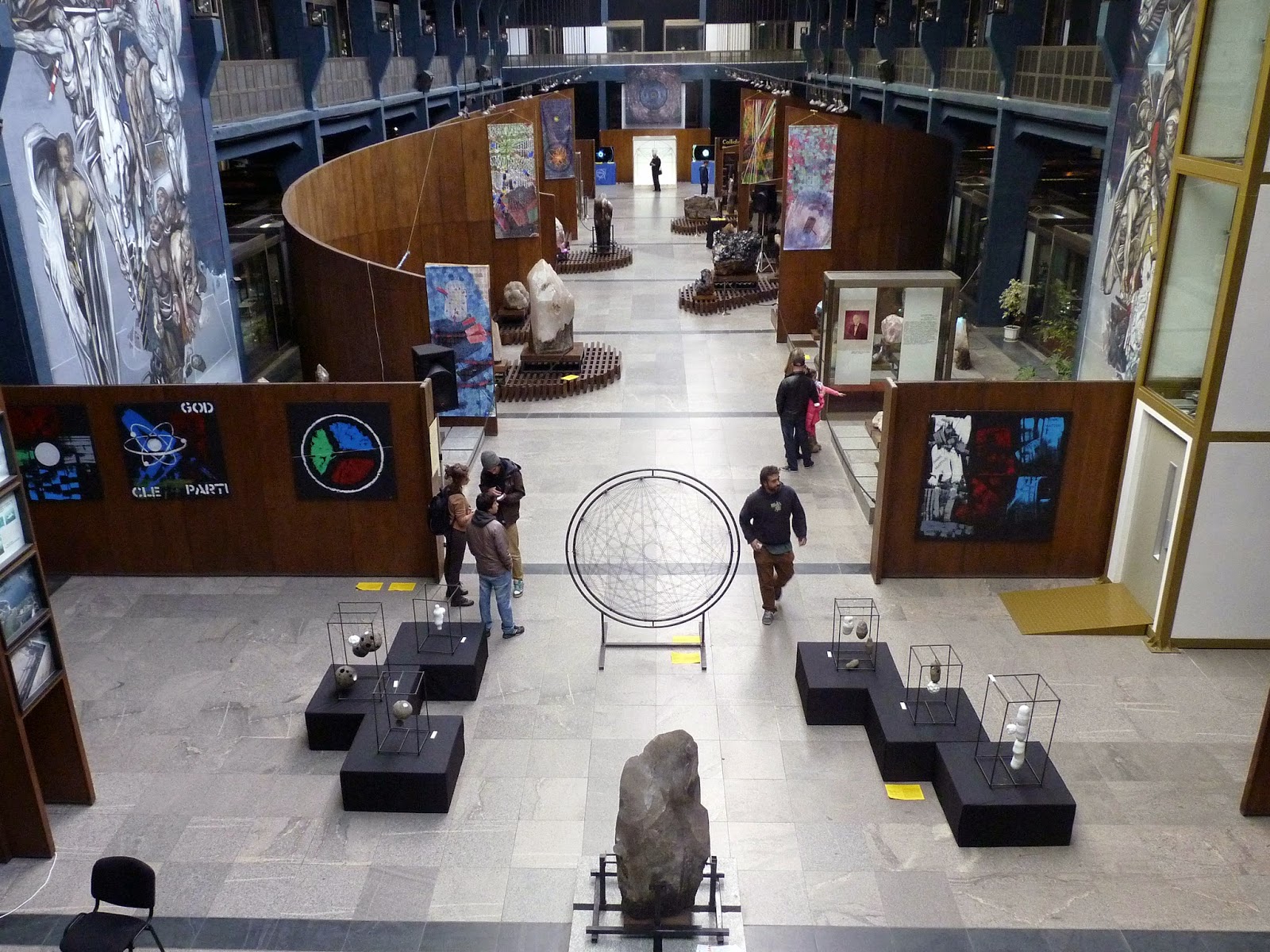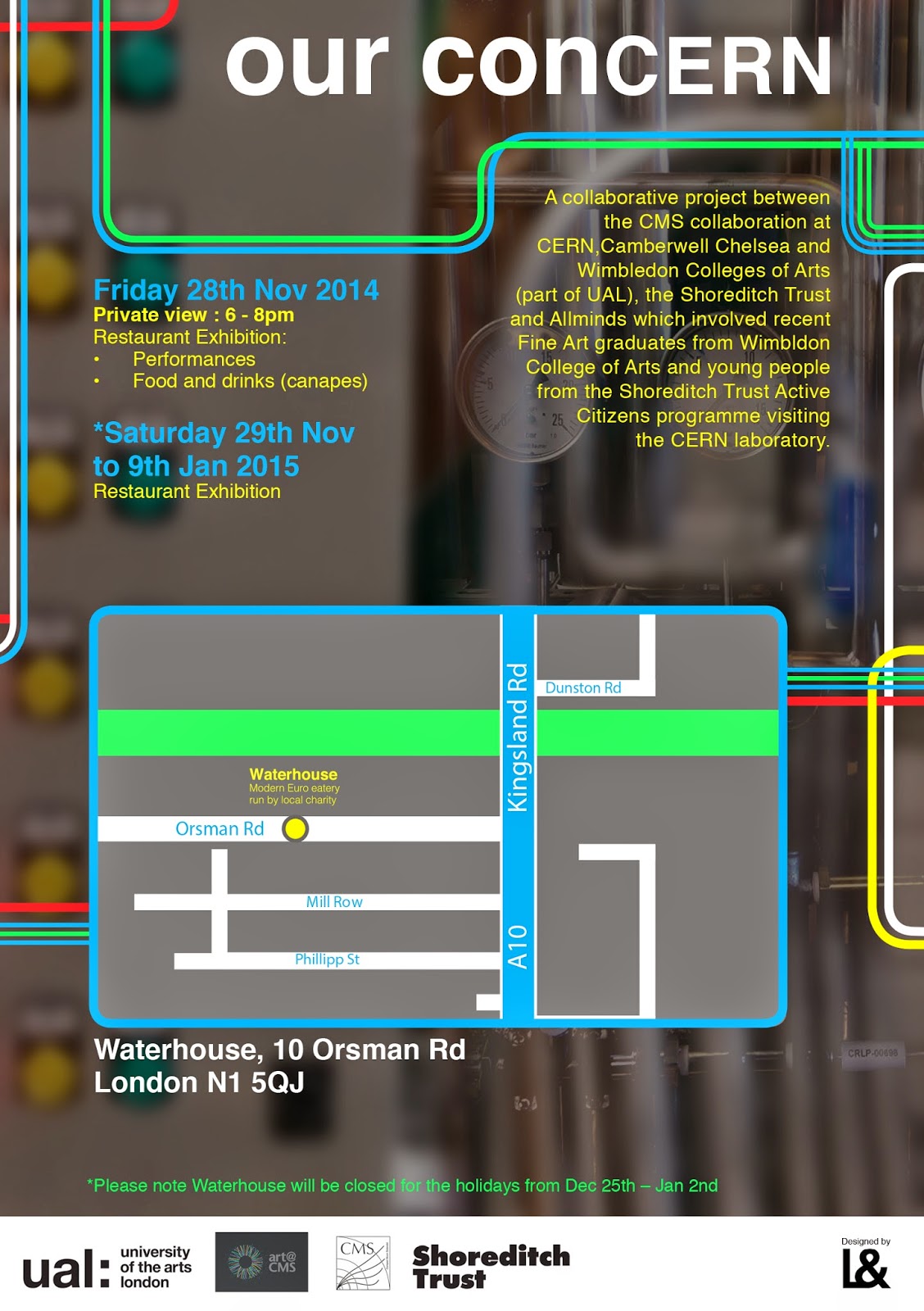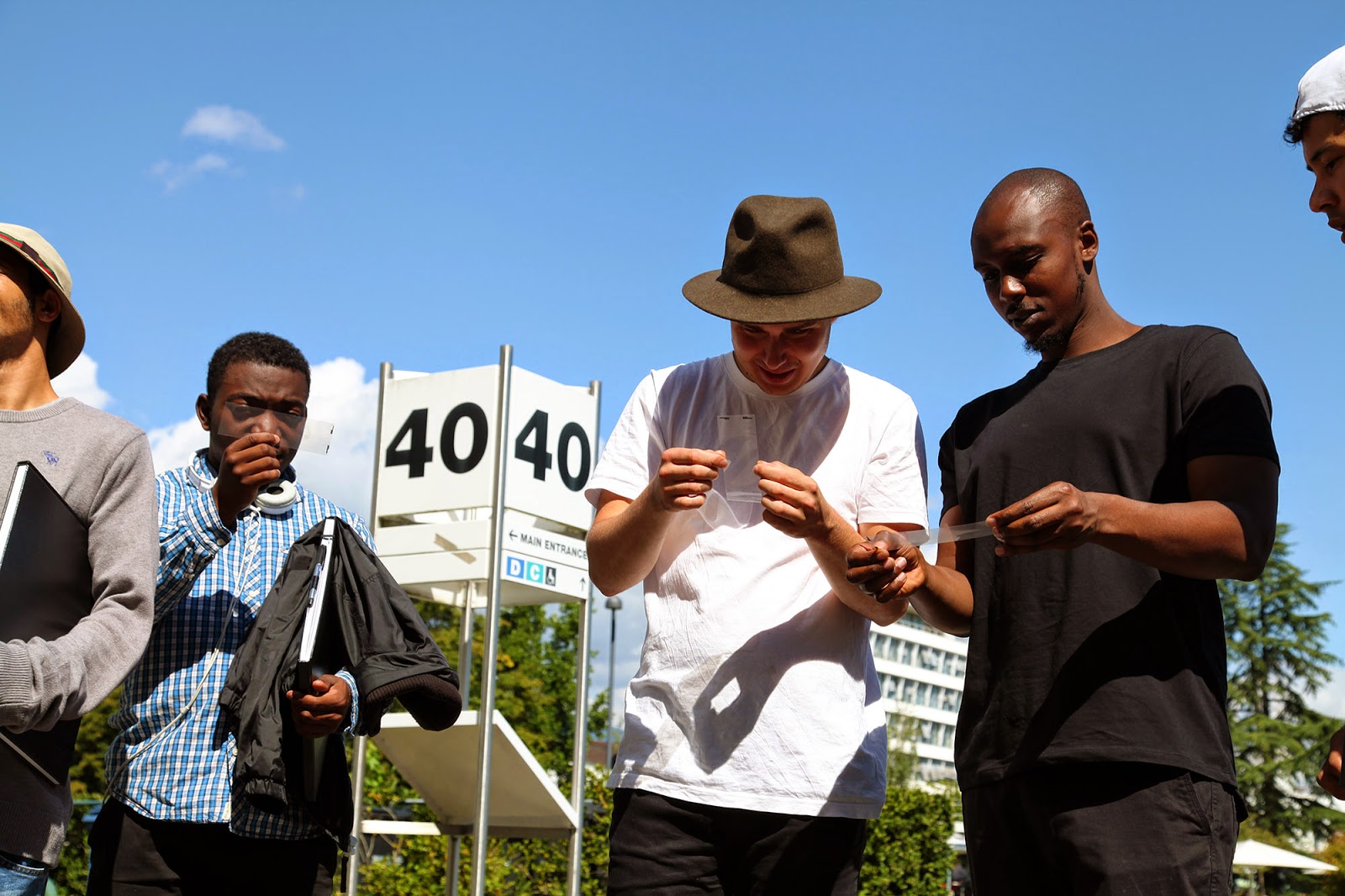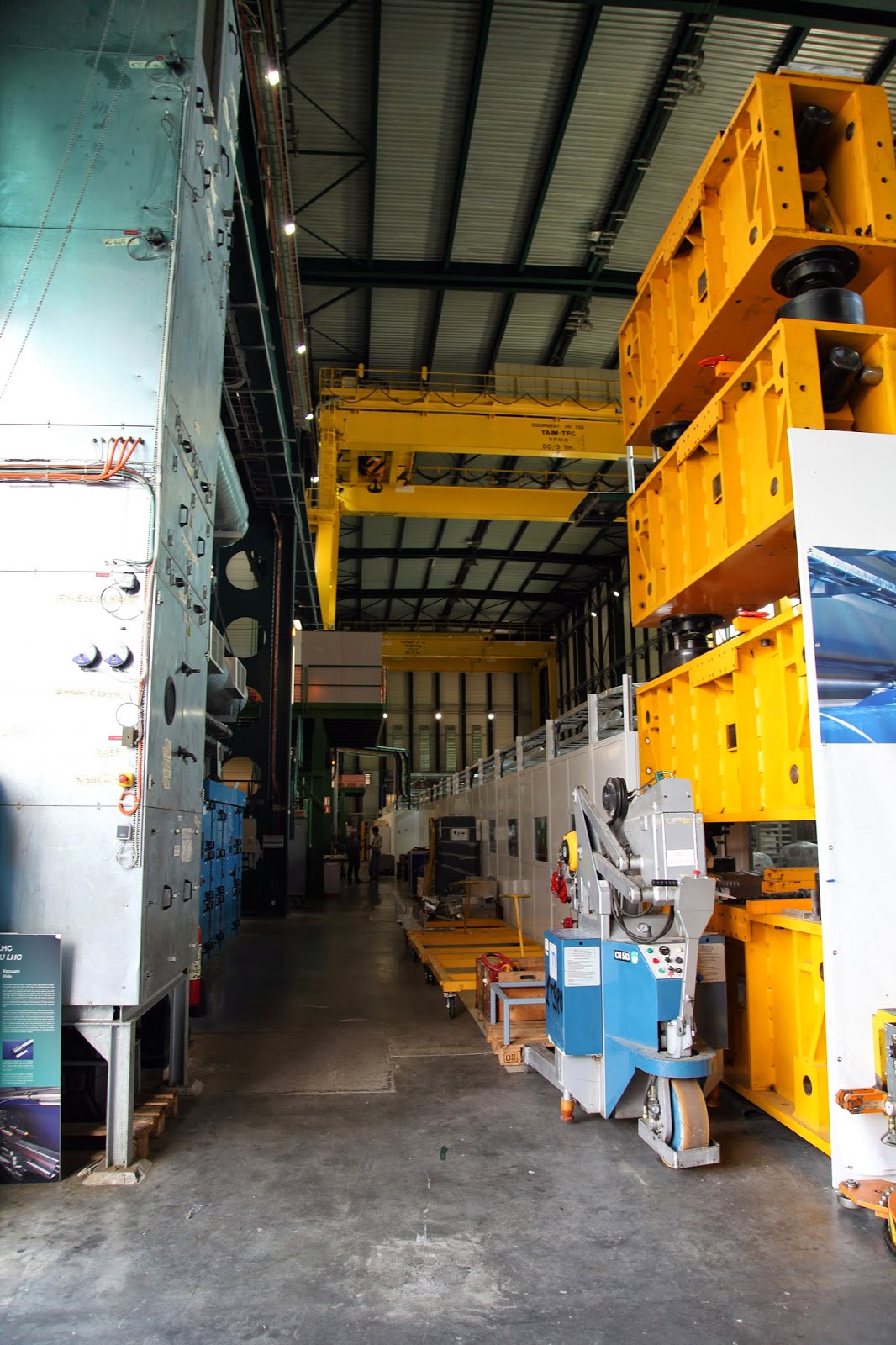Art@CMS has the honor to present with a selection of collaborating artists :
Chris Henschle [AUS] - Edge of the ObservablePaco Falco [IT] - The Forms of the Infinite
Alison Gill [UK] - Stranger Than Paradise, Detector Kissing Gate
Xavier Cortada [US] - HIGGS discovery
Michael Hoch [AUT] - The GodParticleHuntingMachine
Chris Henschke, AUS [With physicist Wolfgang Adam HEPHY/ AUT
Audi-visual art: Edge of the Observable 2014
Is an audio-visual artwork which explores the limits of
materiality and knowledge, through an experimental re-manifestation of data
from experiments at the Large Hadron Collider (LHC). The experiments undertaken
at the LHC probe the nature of the universe through the focusing of trillions
of electron volts on unimaginably small particles that are accelerated to
almost the speed of light around the twenty seven kilometre ring. When they
collide with each other, they release immense energies for an instant of time
which are captured by gargantuan detectors. Such spatial, temporal and energetic
extremes contain an essence of the sublime, a term that can be described as the
sensation of apprehending that which is beyond humanity’s grasp or limits of
understanding. The philosopher Immanuel Kant posits two types of sublime: the “mathematical”
which deals with scale, and the “dynamic” which deals with the might and power
of nature. According to Kant, we find ourselves at the limits of our ability to
intuitively grasp or aesthetically measure such factors, due to the ‘limitations
of the finite, human faculties of sensibility’. Both forms of the sublime are
encapsulated by the complexity of the LHC and the tremendous energy it creates,
however this is a kind of inversion of the Kantian sublime of scale and dynamics,
it is the sublime of the near-infinitely small yet near-infinitely energetic. And
the LHC manifests another limit, the limit of knowledge itself, as the
experiments undertaken are literally testing the boundaries of scientific
knowledge and our understanding of the universe.Audi-visual art: Edge of the Observable 2014
------------------------------------------------------------------------------------------
Paco Falco IT [With physicist Pier Luigi Paolucci INFN/IT]
Acrylic painting: The Forms of the Infinite 2014
To decipher the
codes of genesis, to reveal the design of the great architect of the universe,
the equation of life even before life, of sound even before sound, of colour
even before colour. To travel backwards along the way of creation, searching
for an equilibrium between the infinite and a tormenting perfection. To seek
the significance of the birth of sense. To abandon oneself to the “mad flight”
of the eternal challenge between God and man. Paco Falco’s research wanders
into the darkness of sound where colour is generated in light and matter
acquires form, emerging pure and luminous from the incessant labour of forces
engaged in a struggle, the sense of which appears to be inscrutable.
Is God revealing
himself upon defeating the devil in an eternal battle or no? Perhaps God has
nothing to do with it. No point in casting the glove of challenge. Matter and
the universe are neither damned nor blessed. Enough researching. Even along the
impassable paths that lead to ancestral reigns, lacking coordinates within
dilating space in an immeasurable time. The instruments are an explosion of colours,
the unimaginable velocities leaving a trace of their course. Dark matter
reveals its tints in the reunification of the infinite points that is composed
of. It imposes itself, giving consistency to an apparent inconsistency. The
beginning after the explosion of chaos lightly emerges, placid, beyond the
reticules. It isn’t frightening. The meaning outlines itself in traits without
anguish. The infinitely small may be perceived through the light and its
passage leaves an inviting trace. -----------------------------------------------------------------------------------
Alison Gill UK [with physicist Ian Shipsey Oxford University/ UK]
Sculpture: Stranger Than Paradise 2013
In the six sculptures which make up, magnetised
objects hang in steel frames with dimensions taken from Giacometti's early
Surrealist works. They operate in abstract terms, but also reference scientific
modelling, and in doing so they alternate between micro and macro levels. Just
what are those cratered balls with blind alleys, tunnels and holes? Atomic
particles? Planets? Or people in relationships? Gill points to the potential
narrative of those relations through the sub-titles of these pieces, all of
which incorporate a fairy tale which can also be read as linking to one of the
six particles which are quarks in the Standard Model: Sleeping Beauty
(Beauty/Bottom); Rumpelstiltskin (Strange); Tom Thumb (Down); Rapunzel
(Truth/Top); Frog Prince (Charm) and Magic Bean (Up).
The science of Stranger Than Paradise is too simple
to deceive. Everyone understands magnetic force. Yet a residual air of mystery
does remain whenever bodies act without visible cause. And if the objects do
stand in for people, they put me in mind of how behaviour can appear to come
from nowhere, even the extremes which are seen in those early Giacometti sculptures.
Our speculation as to causes will be rooted in psychology rather than science.
That might set us wondering, though, whether the former might eventually be
reduced to the latter through an ultimate understanding of the chemistry and
physics of the brain, just as the sculpture's interactions can be explained by
magnetic and gravitational laws. What are the shapes, by the way? Gill explains
that they all began from either the sphere or a Russian doll, and that, too,
provides an appropriate combination of contrasts: they start from either
perfect rationalism, for which read science or maths; or from a sequential concatenation
of myth, from art or religion.
Sculpture: Detector (Kissing Gate) 2013
Uses the invisible force of magnetism, but to rather different effect
– to influence the opening, closing and turning of a sculptural circle which
becomes a portal. Here again the art and non-art references come together. This
is a gate, a potential point of entry to alternative experiences, including,
perhaps, the magnetic attractions of romance. It also looks like a bicycle
wheel removed from its context, which summons Duchamp’s first readymade. The
sculptural placement of string across a hole brings Barbara Hepworth to mind.
But its pattern takes us back to Gill’s interest in topology: it’s a ‘Mystic
Rose’’ produced by linking equidistant points around a circle to each other. --------------------------------------------------------------------------------
Xavier Cortade / US [with physicist Pete Markowitz FIU/ US]
Digital Art: HIGGS discovery 2013
Working together, Cortada and Markowitz developed an art installation: five banners give the different strategies to sift through the voluminous collisions recorded by the CMS experiment in the search for the Higgs particle. The foreground of each banner shows an event which is a possible candidate for each of these different decays of the Higgs-like particle to a final state: two photons, two Z, two W, two bottom quarks or two tau leptons. The backgrounds reflect the additional breadth of the physics program. Each depicts selected pages from every article published by the collaboration. In a very real sense, the banners serve as an homage to the CMS collaboration's more than 4000 scientists and engineers whose work is disseminated through those very publications. At the same time the complexity of the work illustrates the challenge in paring down the myriad of interactions to select those scatterings which might have produced a Higgs boson.
The resulting exhibit is about honouring the people who have increased our understanding of the universe -- those scientists, engineers, technicians and others from around the entire planet whose work and names are showcased in these banners.
------------------------------------------------------------------------------------------------------------------------
Michael Hoch, AUT
Collage: The GodParicleHuntingMachine, 2013
have been working for several years as a member of the CMS Collaboration mainly on the central tracker. The CMS experiment is a science installation as high as a 6-floor building, designed for measuring subatomic processes produced by collisions of protons in the LHC. This huge measuring device is built with a precision of a thickness of a human hair. It takes 40 000 000 pictures per second of the proton collisions which create states of matter predicted by theory but not yet observed. Both CMS and the LHC are not only engineering marvels and at the forefront of science and technology, but have intrinsic geometries with exceptional aesthetics that can be viewed as work of art. The aesthetics of CMS are associated with its functionality as gigantic measuring device. Periodic multiplicities emerge out of the physical measurement constraints. A strict scientific precision allows us to unfold the secrets of nature. In my artwork the humans designed strict scientific apparatus merge with the quasi chaotic appearance of nature. However nature also follows strict rules in its creation.
-----------------------------------------------------------------------------------------


























































